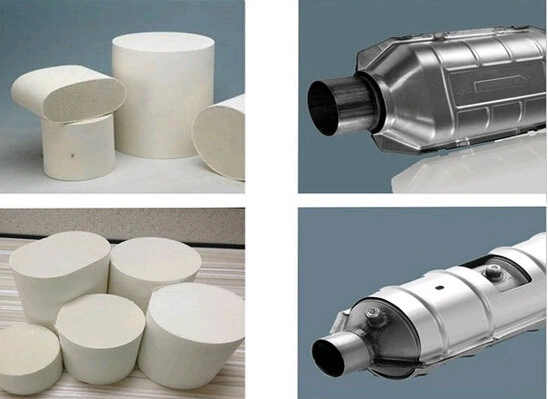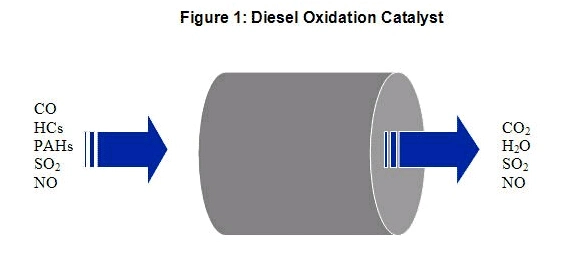DOC Catalytic Converter, Honeycomb Ceramic Catalytic Converter:

The diesel oxidation catalyst (DOC) has become a leading retrofit control strategy in both the onroad and nonroad sectors throughout the world, reducing not only PM emissions but also CO and HC emissions. Using oxidation catalysts on diesel-powered vehicles is not a new concept. Oxidation catalysts have been installed on over 250,000 off-road vehicles around the world for over 30 years. Over 1.5 million oxidation catalysts have been installed on new heavy-duty highway trucks since 1994 in the U.S. These systems have operated trouble free for hundreds of thousands of miles. Oxidation catalysts have been retrofitted on over 750,000 on-road and off-road vehicles worldwide. Oxidation catalysts can be used not only with conventional diesel fuel, but have also been shown effective with biodiesel and emulsified diesel fuels, ethanol/diesel blends and other alternative diesel fuels.
In most applications, a diesel oxidation catalyst consists of a stainless steel canister that contains a honeycomb structure called a substrate or catalyst support. There are no moving parts, just large amounts of interior surface area. The interior surfaces are coated with catalytic metals such as platinum or palladium. It is called an oxidation catalyst because the device converts exhaust gas pollutants into harmless gases by means of chemical oxidation. In the case of diesel exhaust, the catalyst oxidizes CO, HCs, and the liquid hydrocarbons adsorbed on carbon particles. In the field of mobile source emission control, liquid hydrocarbons adsorbed on the carbon particles in engine exhaust are referred to as the soluble organic fraction (SOF)- the soluble part of the particulate matter in the exhaust. Diesel oxidation catalysts are efficient at converting the soluble organic fraction of diesel particulate matter into carbon dioxide and water. A conceptual diagram of a diesel oxidation catalyst is shown in Figure 1.

Physical Properties:

The diesel oxidation catalyst (DOC) has become a leading retrofit control strategy in both the onroad and nonroad sectors throughout the world, reducing not only PM emissions but also CO and HC emissions. Using oxidation catalysts on diesel-powered vehicles is not a new concept. Oxidation catalysts have been installed on over 250,000 off-road vehicles around the world for over 30 years. Over 1.5 million oxidation catalysts have been installed on new heavy-duty highway trucks since 1994 in the U.S. These systems have operated trouble free for hundreds of thousands of miles. Oxidation catalysts have been retrofitted on over 750,000 on-road and off-road vehicles worldwide. Oxidation catalysts can be used not only with conventional diesel fuel, but have also been shown effective with biodiesel and emulsified diesel fuels, ethanol/diesel blends and other alternative diesel fuels.
In most applications, a diesel oxidation catalyst consists of a stainless steel canister that contains a honeycomb structure called a substrate or catalyst support. There are no moving parts, just large amounts of interior surface area. The interior surfaces are coated with catalytic metals such as platinum or palladium. It is called an oxidation catalyst because the device converts exhaust gas pollutants into harmless gases by means of chemical oxidation. In the case of diesel exhaust, the catalyst oxidizes CO, HCs, and the liquid hydrocarbons adsorbed on carbon particles. In the field of mobile source emission control, liquid hydrocarbons adsorbed on the carbon particles in engine exhaust are referred to as the soluble organic fraction (SOF)- the soluble part of the particulate matter in the exhaust. Diesel oxidation catalysts are efficient at converting the soluble organic fraction of diesel particulate matter into carbon dioxide and water. A conceptual diagram of a diesel oxidation catalyst is shown in Figure 1.

Physical Properties:
| Property (uncatalyzed) | 100/17 | 200/12 | |
| Cell density | cpsi | 100 | 200 |
| cpscm | 15.5 | 31.0 | |
| Wall thickness | inch | 0.017 | 0.012 |
| mm | 0.432 | 0.305 | |
| Open frontal area (OFA), % | 34.5 | 34.5 | |
| Geometric surface area (GSA) | Inch2 | 33.3 | 47.0 |
| m2/l | 1.31 | 1.85 | |
| Hydraulic diameter | Inch | 0.083 | 0.059 |
| mm | 2.11 | 1.49 | |
| Modulus of rupture (psi/cpscm) | 350 | 300 | |
| Porosity (%) | 48 | 48 | |
| Coefficient of thermal expansion 102cm/cm/ (20-800) --maximum average | 5 | 5 | |
| Mean pore size (micron) | 13 | 13 | |
| Melting temperature () | 1460 | 1460 | |